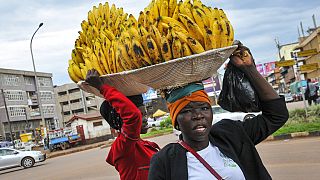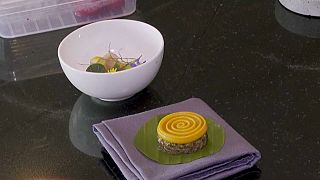Brazil
On the outskirts of Rio de Janeiro, the Santa Cruz district is reputed for its high-quality cassava root - or aipim, as it's known locally. It is also known as manioc or yuca.
Manihot esculenta is the scientific name of the plant, native to South America and cultivated in tropical regions for its starchy tuberous root.
It's easily pulled from the ground, roots are separated, and the stem is kept for later use, generating new plants.
Fresh roots can be found at markets in all regions of Brazil, the northern part of the country being the largest consumer.
In Rio de Janeiro, Tom Le Mesurier begins his all-day food tours at streets markets like this.
"It's central to Brazilian cuisine," says Le Mesurier, holding a cassava root.
"Here in Brazil, it's used for a really wide variety of different dishes, both savoury and sweet, and both using the whole root and also the starch, which is extracted from the root, which is tapioca."
Tapioca flours are extracted by settling the white liquid extracted from the root.
Tapioca is also the name of a snack that's been growing in popularity around Brazil.
Starchy tapioca flour is placed on a frying pan without oil. It melts and solidifies into a pancake and is then filled with a variety of ingredients, whether sweet or salty. It's a favourite for visitors from abroad.
Tapioca can also be made in a more refined manner, like at the Aprazivel restaurant in Rio.
Here, a high-quality kitchen team prepare Brazilian cuisine with ingredients such as the crab that goes into the tapioca.
Under the instructions of chef and owner Ana Castilho, manioc root is made into one of the most popular side dishes: fried aipim or aipim frito.
Manioc or cassava is the main ingredient with a different name, aipim is a softer kind of manioc.
"Manioc has millions of uses, besides being very nutritious," says Castilho.
"The Brazilian people eat it abundantly from north to south, from east to west, and this is the most classical way to eat it, as is done in drinking bars and in family houses, which is fried manioc. It's peeled, cooked, and fried, and it's delicious."
Tucupi broth is made from liquid extracted from the hard variety of manioc root from the Amazon.
It's popular in the northern region but can be tasted in a few establishments in Rio.
"This is food that can be present at any table at any banquet anywhere in the planet, because it is basically nutrition, it warms you up, it embraces, and nourishes," says Castilho.
In his production kitchen, chef Ecio Cordeiro de Mello is making one of Brazil's favourites: shrimp bobó or bobô de camarão.
While one kilogram of manioc roots boils inside a pressure cooker, he mixes ingredients to add flavour to dish, which has African origins.
Some ingredients include chopped garlic, cilantro, coconut milk, and red-hot chili peppers.
When ready, manioc root is pureed in a mixer and later blended with savoury ingredients.
Fresh shrimp is fried separately using olive oil and dendê palm oil, typical of Bahia, originating in Africa.
All the ingredients are mixed, the shrimp enter the puree - Shrimp bobo is ready.
At the São Cristovão market, visitors from Northeastern Brazil come on weekends for fun and food.
Here can be found a variety of dry and wet manioc flours.
Besides the starchy tapioca kind, dry manioc flour is made by grinding and toasting the roots once the water has been extracted.
There are dozens of different kinds of manioc flours in different regions Brazil, many are sold here.
Teresa Corção is the founder of the Maniva Institute that promotes sustainable foods and studies manioc, its history, and its uses.
She's now part of a collaborative effort building a collection of manioc flours, to be housed at a university in capital, Brasilia. People from all over Brazil are contributing to the project.
Corção prepares another basic manioc recipe, known as "farofa".
On top of minced fried purple onions and egg, dry manioc flour is poured, making one of Brazil's most popular side dishes. It goes wells with red meats, barbecue, chicken or on its own.
"The Portuguese arrived here in 1500 and brought people and their customs. Their main foodstuff was bread. They tried to produce wheat, but Brazil was never adequate, due to the humidity and heat," explains Corção.
"They realised there was an indigenous manioc culture here, so many recipes formerly made using wheat in Portugal were now made with manioc flour in Brazil."
Products baked using tapioca and manioc derivatives are becoming increasingly popular among people with gluten-free diets.
Renata Araujo's bakery makes frozen tapioca bread and cookies distributed in local health stores.
One of her specialties is the very popular tapioca cheese puff - or "cheese bread" - found in almost every bakery in the city.
Araujo adds ingredients such as beets, turmeric and seeds.
"Instead of wheat, we use manioc. Manioc is an ancient Brazilian food the indigenous used in their daily life," she says.
"It was forgotten in Brazilian culture, but here at Realimentare, we value the use of manioc and its sub products."
"Tapioca cheese puffs equal affection. To go to someone's house, prepare coffee with that smell and cheese tapioca bread baking in the oven says a lot about our culture, our way of relating to others. It's a very, very Brazilian recipe, and it uses no wheat."
This Brazilian favourite originated in the state of Minas Gerais state but is now enjoying popularity across the country.












01:07
China's visa-free policy for five Latin American countries takes effect
01:07
New Brazil national football team coach Ancelotti finds his feet
01:45
Two Brazilian nuns go viral for beatboxing and dancing live on TV
01:10
Ancelotti arrives in Brazil to take over as head coach of the national team
02:19
Zimbabwean, European artists collaborate on climate, sustainability
Go to video
New museum in Rotterdam looks at migration through the lens of art